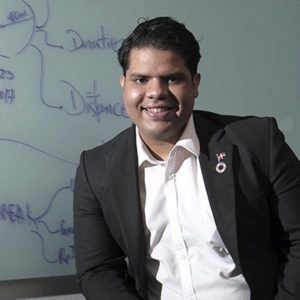Peter Yang is the co-founder of Pokeworks. A second-generation restaurateur, Yang grew up in the restaurant industry from a young age. After a brief career in structural engineering, Yang partnered with his father to found a new restaurant in Manhattan. From here, he went on to help found Pokeworks, a Hawaiian inspired poke burrito and bowl eatery with a focus on sustainable and healthy lifestyles. Today, this chain is one of the fastest growing poke brands in the US. Yang himself has won the Forbes 30 Under 30 for his work with Pokeworks. In today’s age of globalization, diverse cultural foods are more easily accessible than ever before, thanks to entrepreneurs like Peter Yang.
Author Archive for GagerCR21
Peter Cashmore is the CEO and founder of Mashable. Mashable started as a tech blog in 2005, with Cashmore as the only writer. He began this blog as a way to inform people about his passion, technology and its societal effects. Through his efforts, he grew his blog into a site that reaches 40 million viewers. After twelve years working on his website, he sold it for 50 million dollars to Ziff Davis. He has won several awards, most notably Forbes 30 Under 30 and Time Magazine Most Influential People In the World. After his success with Mashable, he has moved on to create many new startups as well as work with other entrepreneurs as an advisor. Cashmore has taken a dream that many people of younger generations aspire to, the ability to make it big on the web, and turned it into a successful springboard to future projects.
Alexander Kulitski- Tech minded entrepreneur for entrepreneurs
Alexander Kulitski is the owner of Smart IT, a business where he and a group of his friends build custom software and web applications for other small businesses. He works with enthusiasm and innovation and was responsible for creating the first online ticket sale software in Belarus, Bycard. This service remains a hugely popular ticket vendor to this day. He doesn’t just work with small businesses, however. Smart IT handles tech support and development for several international corporations as well. Smart IT has seen huge success and growth since its founding. Despite its growth, Kulitski still maintains heavy involvement with each client in order to ensure that they receive the highest quality. In a world where tech is only becoming more and more integrated with everyday life, entrepreneurs like Kulitski will only have more and more demand.
When someone dies, their family and friends are left with only the memories they have, and a gravestone or other reminder of their presence. Humans have found many ways to store the bodies of the dead. Burial, burial at sea, catacombs, cremation, and many others. But in today’s world, where technology has allowed for so much innovation in nearly every field, what about the funerary field? Much of the technological advancements here are quality of life ones, better embalming solutions, more types of coffin, and more efficient cremation methods. Enter Adelle Archer.
After losing her mentor in 2015, Adelle was made one of the keepers of her ashes. She decided, however, that a cremation was not enough to memorialize someone with a legacy such as her mentor’s, and so she decided to turn the ashes into a diamond as a way to preserve them forever. And this is where the idea came to found Eterneva.
The process of turning one’s remains to diamonds is quite simple, though it requires the right tools. After cremation, the carbon residue is extracted, purified, and compressed at extremely high pressure. What is left is a precious diamond and reminder of the departed.
Although the subject of what should be done with a body is one charged with both religious and societal biases, this innovative new technology has already seen great success and popularity among those looking to preserve their loved one. It seems that this funerary practice may be here to stay.
Furthermore, a process such as this would be quite useful in communal burial situations, such as the left over carcasses of animals that are butchered. Instead of letting the remaining parts of a pig or cow simply be cremated or buried, it could be turned into something of value that someone might want to purchase.
Alex de Bernede and Marius Jacob, Founders of the Darmo Art Gallery
When you think of art collectors, what comes to mind? Is it some eccentric billionaire business man or old recluse in a fortress sized mansion? This often accurate stereotype has lead plenty of younger people to believe that the art world is exclusionary and for those with more money than they know what to do with. Enter Alex de Bernede and Marius Jacob, two young entrepreneurs with the goal to challenge this perception. While studying art in university, these two aspiring artists realized that for the creation and appreciation of art to survive, the up and coming generations need to not only understand and enjoy art, they need to be able to make a career of it. With the increasing difficulty for new artist’s to find platforms for their work, Bernede and Jacob decided to do something new. This idea has become the Darmo Art Gallery, a place for young artists to display their works. The duo started with only $2,000 and a goal, but now, they host highly successful expositions where these indie artists can make some serious money and a name for themselves. A lot of famous artists only get that fame after their life or art career ends. Artists like Vincent Van Gogh and Johannes Vermeer never received the fame and monetary recognition their works earned within their lifetimes, while figures like Pablo Picasso are the exception. If new institutions like the Dormer Gallery become a common and successful part of the art world, then what is usually seen as a past time for the rich or a career for those doomed to obscurity may rise up to join the likes of lawyers, plumbers, and computer tech as common and successful vocations.
In this day and age, predictive ai has become a tool with loads of potential. In the right application, it can be used for identifying weather disasters, marketing analytics, and even finishing sentences. Rainier Mallol, a thirty year old entrepreneur who co-founded and is now president of AIME, or artificial intelligence in medical epidemiology, has put this tool to quite effective use in the world of viral outbreaks.
Started in his graduate study, AIME was started as a way to predict outbreaks of Dengue and other similar infectious diseases, and provide health officials with information to avoid or alleviate them. Since then, AIME has climbed to the Forbe’s Top 40 World Changers, and boasts a 86.37% accuracy. So far, it has been successfully used in Malaysia, Brazil, and the Philippines.
While the software currently only works to predict three mosqutio-born diseases, those being Dengue, Chikungunya, and Zika, this technology, with a little more information, could be used for many other pandemic situations before they become out of control. Though AIME was created in 2016, it has never been more relevant than in today’s post covid world. Millions of people would have benefited from AIME’s ability to predict the viral outbreak of covid and offered solutions on how to minimize its effects. With the right amount of investment in technologies like AIME, we might never see another outbreak like covid again, a post-pandemic world.
Copyright © 2025 All Rights Reserved

